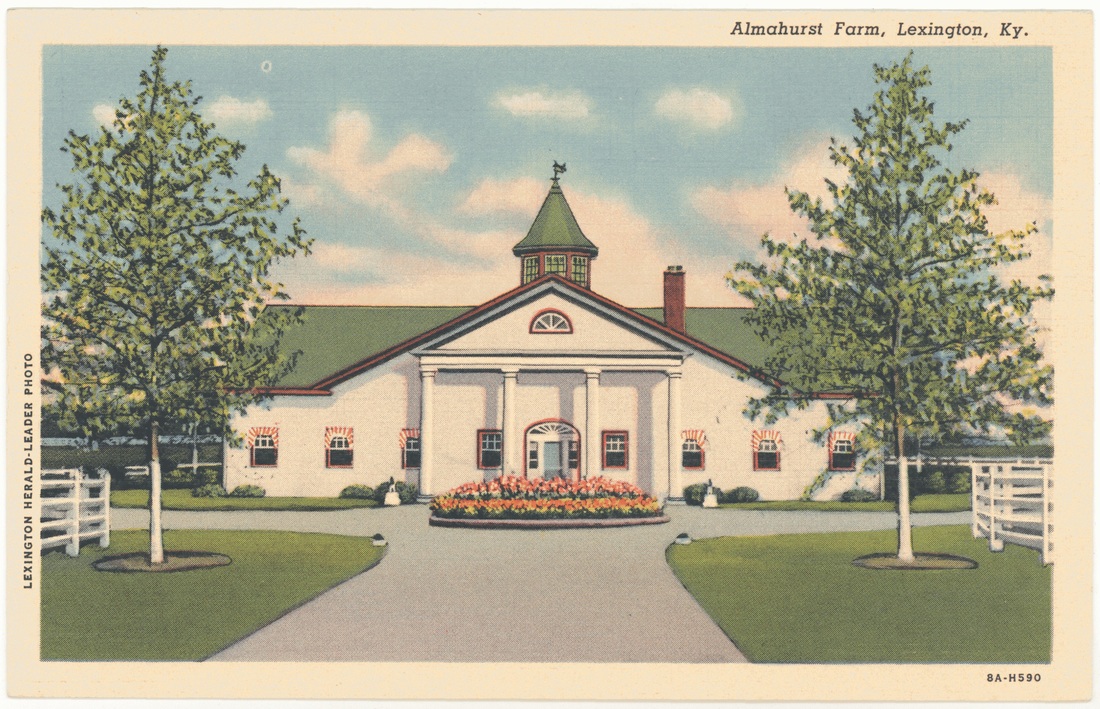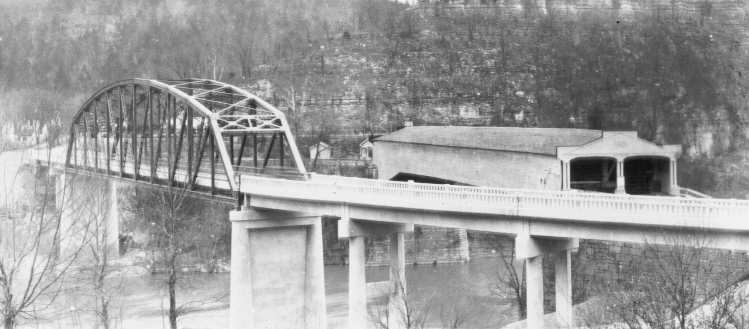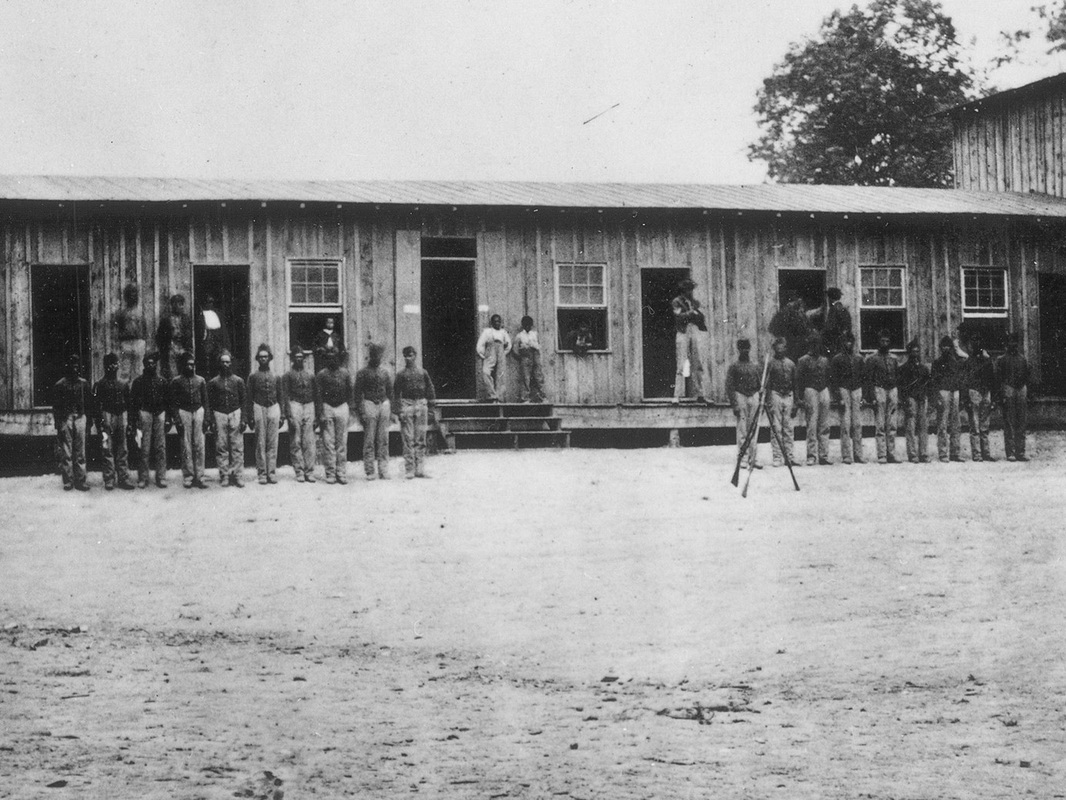|
|
Almahurst Farm Marker Number 565
Location Old Coach Stop, Jct. of US 68 & KY 169, Nicholasville This is part of the original land granted to James Knight, 1750-1831, for his services in the Revolutionary War. A portion owned by his heirs in 1962. Among the famous horses bred, foaled, and raised on this farm were: Greyhound, world's champion trotter of all times; Peter Volo, founder of one of the great trotting families; Exterminator, known wherever thoroughbreds are raced. Bethel Academy Marker Number 1830 Location Entrance to Asbury College, KY 29, Wilmore This was the second Methodist school in the United States. In 1790 Bishop Francis Asbury laid plans for Bethel Academy, four miles southeast of Wilmore on cliffs above the Kentucky River. It was operating by 1794. It was closed ca. 1804, due to lack of funds and Indian hostilities. A second site was built in Nicholasville, 1820-93. (Reverse) Asbury College - Established in 1890, this school was named for Francis Asbury, the first Methodist bishop and circuit rider in the United States. Asbury Theological Seminary was established at Asbury College in 1923. The original Bethel Academy site and Asbury College Administration Building are listed on the National Register of Historic Places. Butler's Birthplace Marker Number 823 Location US 27 & Jct. of Hall Rd., S. of Camp Nelson Cemetery entrance Gen. William O. Butler was born here in 1791 and died in Carrollton, KY in 1880. During the War of 1812 he participated in the battles of River Raisin, Pensacola, and New Orleans. He was in Gen. Andrew Jackson's staff 1816-17. He was cited for heroism in Mexican War 1846-48. He served as a U.S. Congressman 1839-43. Although defeated for Governor in 1844, Vice Pres. 1848 and the U.S. Senate in 1851, he was one of the most prominent, best-liked Democrats in the state. Camp Nelson Marker Number 1515 Location US 27, in park at Camp Nelson, S. of Nicholasville Camp Nelson was named for Major General William Nelson who established the first Union recruiting center south of the Ohio River in 1861. The original camp in Garrard Co. was called Camp Dick Robinson. For better protection from invading CSA armies of Tenn., the camp was moved to the Jessamine side of the Ky. River. Major General George H. Thomas renamed it Camp Nelson. The camp was occupied until the end of the war. It is now a U.S. military cemetery. (Reverse) Maj. Gen. William Nelson - Major General William Nelson was a navy lieutenant. When he founded Camp Dick Robinson, Gen. Nelson was the only naval officer, CSA or USA, to become a full-rank Civil War major general. He persuaded Lincoln to abandon a "hands off" policy in Ky. and to supply 5,000 guns to Union supporters. He was killed by fellow Union officer, Jeff C. Davis, in a personal dispute at the Galt House in Louisville on September 29, 1862. Camp Nelson Marker Number 2222 Location Camp Nelson, US 27 south of Nicholasville Camp Nelson was founded in 1863 as a Union supply depot, hospital, and encampment. In 1864, Camp Nelson became Kentucky's largest, and the nation's third largest, recruitment center for African-American soldiers, the U.S. Colored Troops (USCT). Eight USCT regiments were organized here and saw action in Kentucky and Virginia. (Reverse) The USCT were emancipated from slavery upon enlistment and many brought their wives and children into camp, who were freed after a March 1865 Congressional Act. 23,300 slaves were freed here. Camp Nelson included 4,000 acres and 300 buildings and provided men and supplies for Knoxville, Atlanta, and Saltville- Marion, Va., campaigns. Camp Nelson Covered Bridge Marker Number 1513 Location in park at Camp Nelson, US 27 This is the site of the first bridge across the Kentucky River. It was designed in 1838 by famous bridge builder, Lewis V. Wernwag. With two lanes, each 12 feet wide, it was a single span structure; 240 feet between the abutments which still stand. It served as a main artery between the North and South during the Civil War. It was condemned in 1926. When it was razed in 1933, it was the longest wooden cantilever bridge in America. Camp Nelson National Cemetery Marker Number 1610 Location Camp Nelson, US 27 Camp Nelson National Cemetery is one of 40 burial grounds listed by Congress in 1866 to become one of the National Cemetery sites. Although no battles were fought in the immediate area, a large camp hospital was located here. There were 1,183 men buried in this cemetery between July 28, 1863, and February 4, 1866. This included disinterments from several battlefields. The stone wall was built in 1867-68. (Reverse) Camp Nelson National Cemetery In June and July of 1868 after the Civil War, over 2,000 dead were removed from five areas of Kentucky and reburied here. This included 975 bodies from the battle of Perryville. Also buried here are soldiers from the Spanish-American War, World Wars I and II, Korea, and Vietnam. Expansion of the cemetery was made possible by a ten-acre donation in May of 1975. Camp Nelson Refugee Camp Marker Number 1965 Location Camp Nelson, New US 27 at Hall Rd. Established in 1863 to house families of African American soldiers, Camp Nelson became the chief center issuing emancipation papers to former slaves. The Army's withdrawal from the camp in 1866 exposed refugees to violence of white "regulators," who were opposed to presence of freed African Americans. (Reverse) Conditions at Refugee Camp Many women and children died from disease and exposure to weather in the make-shift camp. Brutal expulsion of refugees from the camp in the winter of 1864 was fatal to many. Only efforts by Rev. John G. Fee and other humanitarian workers improved conditions. A school, a hospital, and permanent housing later served up to 3,000 African Americans in their transition to freedom. Chaumiere des Prairies Marker Number 158 Location Catnip Rd., 3 1/2 mi. N. of Nicholasville, US 27 - Chaumiere des Prairies was the estate of Colonel David Meade III, who lived here from 1796 to 1832 and who spent three fortunes on its development. The house was originally a cluster of small buildings connected by stone and brick arcades surrounded by a l00-acre park and garden. Dr. Phillip's Birthplace Marker Number 1473 Location 303 S. Main St., Nicholasville Dr. Lena Madesin Phillips, founder of the National Federation of Business and Professional Women's Clubs, 1919, was born here on September 15, 1881. Her work with the YWCA in 1917, led to interest in the organization of business women. She was instrumental in organizing and was the first President of the International Federation of Business and Professional Women's Clubs in 1930. She died in 1955 and is buried in Maple Grove Cemetery in Nicholasville. Ebenezer Church Marker Number 894 Location Troy-Keene Rd., KY 1267 - One-half mile west. Ebenezer Church was organized by Rev. Adam Rankin, 1793-95. Rev. Robert Bishop came in 1803 when the stone church replaced the original log house. From 1810-18, these two were opposing leaders in a stormy controversy in the early history of Presbyterianism in Ky. Ephraim January donated the land. He and other Revolutionary War veterans are buried there. The Church was abandoned in 1875 and restored in 1953. First celebration Location 1699 Clear Creek Pike, Nicholasville On July 4, 1794, Col. William Price, veteran of the Revolutionary War, held the first celebration of Independence Day west of the Alleghenies. At his plantation, near here, forty veterans dined to commemorate the "glorious birthday of our freedom." High Bridge Marker Number 1381 Location KY 29, 4 mi. SW of Wilmore High Bridge is the highest railroad bridge in the US over a navigable stream (308 feet). It was planned as a suspension bridge for the Lexington and Danville Railroad by John Roebling, designer of the famous Brooklyn Bridge (N.Y. City). Huge stone towers to hold cables were built in 1851. Work on bridge was abandoned during the Civil War. The towers were removed in 1929 by Southern Railroad to permit double tracks. (Reverse) High Bridge - High Bridge was the first cantilever bridge built on the American continent. It was the most remarkable bridge in the US when it was constructed in 1876. Its construction marked the beginning of modern scientific bridge building. It was designed by Charles Shaler Smith and built for the Cincinnati Southern Railroad. The bridge was replaced in 1911, using same foundations without stopping rail service. This marker was presented by the Southern Railway System. Impressed Labor for the Army Marker Number 2448 Location Camp Nelson, Nicholasville - To fill the labor requirements caused by the Civil War, the Union army impressed Kentucky slaves to work on various construction projects. Of special concern were transportation and communication initiatives involving roads and railroads. Loyal owners were paid for their slaves’ work, but many grew annoyed at the loss of power and the army’s demands. (Reverse) Enslaved Men to Soldiers- When Camp Nelson was established in 1863, impressed slaves from local farms provided much of the labor to construct the earthen fortifications & improve the roads that brought men & materials to this supply base. The following year, when blacks were finally allowed to enlist, many of the former laborers became soldiers who trained at Camp Nelson. Jessamine County Marker Number 947 Location Nicholasville, Courthouse lawn, US 27 - Jessamine County was formed from Fayette County in 1798. It was named by Col. John Price, one of the Representatives in Legislature, who stated he named it for a flower which flourishes in the region and for Jessamine Creek. A moving legend tells that the creek was named for Jessamine Douglass, daughter of an early settler, who was stealthily tomahawked by an Indian as she rested on the banks of the creek. (Reverse) Nicholasville - Nicholasville is the Jessamine County seat laid out in 1798 by Rev. John Metcalf, Methodist, who opened the first school in area in 1794. It was chartered by legislature in 1812. It was named for George Nicholas (1754-99); colonel in Revolution, "father of the Kentucky constitution"; first Ky. Attorney General. John McLean, U.S. Supreme Court Justice and dissenter in the Dred Scott case in 1857, spent part of his boyhood years in the vicinity. Jessamine County Hemp Marker Number 1315 Location Nicholasville, Courthouse lawn, US 27 Jessamine County was one of the chief producing counties of hemp. It was third in value of product and also in the number of cordage factories, with 14 in 1840. Peak production was reached in the late 1800s, yielding over 1,000 tons per year, with a value of about $125,000. In 1899, it was one of the three Bluegrass counties which together produced more than one-half of hemp grown in the entire country. (Reverse) Hemp in Kentucky - The first hemp crop was grown in 1775. From 1840 to 1860, Ky.'s production was the largest in the U.S. At its peak in 1850, production was 40,000 tons, with a value of $5,000,000. Scores of factories made twine, rope, oakum to caulk sailing ships and cotton bagging. It remained the state's largest cash crop until 1915. The market was lost to imported jute, freed of tariff. As a war measure, hemp was grown again during World War II. John Curd Marker Number 1795 Location 3 mi. from Wilmore on High Bridge Pike, KY 29 A Rev. War soldier, John Curd lived here. The Virginia General Assembly established a tobacco inspection warehouse on Curd's land in 1786, at the mouth of the Dix River, as well as a public ferry across Ky. River. Curd's 1 1/2-story Federal house, with Flemish bond brickwork and original interior woodwork, is on the National Register of Historic Places. This marker was presented by Descendants of John Curd in 1986. Keene Springs Hotel Marker Number 1671 Location Keene, Jct. KY 169 & 1267 This two-story frame building was erected by Mason Singleton. White sulphur water was discovered circa 1848; its medicinal qualities made the hotel and its adjoining tavern a popular summer resort of the 1840s and 1850s. Captain G. L. Postlethwait was its most noted host. This was a place of safety during the cholera panic in Lexington. The site was sold to A. McTyre in 1857 then to F. S. Wilson in 1868. Sawyer's Inspiration Marker Number 675 Location Hall Rd. & US 27, S. of Camp Nelson Cem. Paul Sawyier, "The River Artist," painted scenes of the Kentucky River gorge while living on a houseboat near here, from 1908 to 1913. The noted artist created over 2,000 paintings, mostly landscapes of Central Kentucky, the State Capitol, the Kentucky River and Elkhorn Creek. He was born in Ohio in 1865 but he spent most of his life in Kentucky. He died in New York in 1917. He is buried in Frankfort. |











